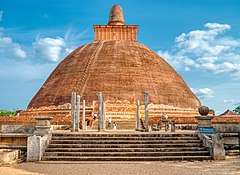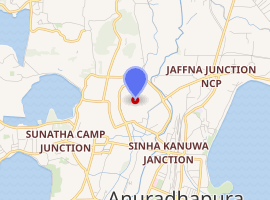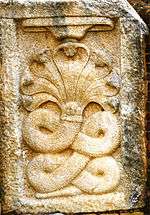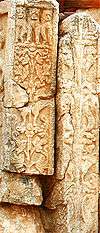Jetavanaramaya
The Jetavanaramaya (Sinhala: ජේතවනාරාමය, jētavanārāmaya) is a stupa, or Buddhist reliquary monument, located in the ruins of Jetavana monastery in the world heritage city of Anuradhapura, Sri Lanka. At 122 metres (400 ft) it was the world's tallest stupa[1] and the third tallest structure in the world[2] when it was built by King Mahasena of Anuradhapura (273–301). He initiated the construction of the stupa following the destruction of the Mahavihara. His son Maghavanna I completed the construction of the stupa.[3] A part of a sash or belt tied by the Buddha is believed to be the relic that is enshrined here.
| Jetavanaramaya | |
|---|---|
ජේතවනාරාමය | |
 Jetavanaramaya | |

| |
| Former names | Denanaka and Denavehera |
| General information | |
| Type | Temple |
| Location | Anuradhapura, North Central Province, Sri Lanka |
| Height | Original Height: 122 m (400 ft), Current Height: 71 m (233 ft) |
| Dimensions | |
| Other dimensions | 233,000 m2 (2,508,000 sq ft) |
| Technical details | |
| Floor area | 5.6 Hectares |
The structure is significant in the island's history as it represents the tensions within the Theravada and Mahayana sects of Buddhism; it is also significant in recorded history as one of the tallest structures in the ancient world;[4] and the tallest non-pyramidal building; the height of the stupa was 122 metres (400 ft),[5] making it the tallest stupa in the ancient world. With the destruction and abandonment of Anuradhapura kingdom in the 11th century, the stupa with others was covered by jungle. King Parakramabahu in 12th century tried to renovate this stupa and it was rebuilt to the current height, a reduction from the original height. Today it stands at 71 metres (233 ft).[2]
The structure is no longer the tallest, but it is still the largest, with a base-area of 233,000 m2 (2,508,000 sq ft).[6] Approximately 93.3 million baked bricks were used in its construction; the engineering ingenuity behind the construction of the structure is a significant development in the history of the island. The sectarian differences between the Buddhist monks also are represented by the stupa as it was built on the premises of the destroyed mahavihara, which led to a rebellion by a minister of King Mahasena.
This stupa belongs to the Sagalika sect. The compound covers approximately 5.6 hectares and is estimated to have housed 10,000 Buddhist monks. One side of the stupa is 176 m (576 ft) long, and the flights of stairs at each of the four sides of it are 9 m (28 ft) wide. The doorpost to the shrine, which is situated in the courtyard, is 8 m (27 ft) high. The stupa has a 8.5 m (28 ft) deep foundation, and sits on bedrock. Stone inscriptions in the courtyard give the names of people who donated to the building effort.
Conception
Following king Jettha Tissa's death his brother Mahasena was consecrated as king by monk Sanghamitta, under the monk's influence king Mahasena brought about a campaign against Orthodox Theravadins dwelling in the mahavihara.[7] The differences between the Theravadins and Mahayanins escalated to an extent to which a penalty was established to any person providing alms to monks dwelling in the mahavihara. The Mahavamsa quotes Sanghamitta: "The dwellers in the Mahavihara do not teach the (true) vinaya, we are those who teach the (true) vinaya, O king".
The Mahavihara was eventually abandoned. The monks dwelling at the premises moved to Malaya Rata and Ruhuna, this followed by the pillaging of Mahavihara by Sanghamitta and minister Sona, all valuable were transferred to Abhayagiri vihāra. The pillaging prompted a rebellion by minister Meghavannabhaya, the minister raised an army from Malaya and set camp by the Duratissaka tank.[7] King Mahasena marches an army to meet minister Meghavannabhaya, where negotiations ensue the night before the battle and the king apologizes for the pillaging and agrees to build a vihara at the grounds of Mahavihara, the Mahavamsa quotes the king: " will make the vihara to be dwelt in yet again; forgive me my fault".[7] Sanghamitta was assassinated by a laborer on the instructions of a wife of the king, following his demise and the construction of parivena by Meghavannabhaya marked the return of monks to the site of Mahavihara.
Thus the construction of Jetavanaramaya began and offered to the monk Tissa, but the monk was accused of a grave offense upon investigation and proof by a minister, monk Tissa was disrobed and expelled from the order. The dakkinagiri monks were then entrusted with the premises of Jetavana Vihara.[3]
Design and construction

As the largest ancient stupa constructed and one of the tallest ancient structures in the world, the structural ingenuity and engineering skills employed for the construction are significant. The foundations of the structure were 8.5m deep and the size of the structure required bricks which could withstand loads of up to 166 kg. The solid foundation lay on bed-rock and the dome was constructed of full and half bricks and earth fill, the unique shape of a perfect ellipsoid allowed for stress and thus allowed the construction of the large structure.[8] The Mahavamsa describes the foundation laying, where fissures were filled with stones and stamped down by elephants whose feet were protected with leather bindings. The bricks used for the construction were a significant development of ancient Sri Lankan engineering, the bricks used for Jetavanaramaya had a composition of 60 percent fine sand and 35 percent clay, the bricks could withstand 44 kg/cm2 (281 kg/in2).[8] Linear elastic finite element analysis under self weight produced a maximum compressive stress of 839 kilopascals (8.6 kg/cm2) at the bottom centre, thus the maximum stress in the dome is ten times less than what the bricks could withstand.[9]
Finely crushed dolomite, limestone, sieved sand and clay provided the bonding material for the bricks. The clay employed was pliable and thus accommodates movement within the structure. One of the sides of the brick was roughened to trap the bonding slurry thus limiting lateral movement.[8] The stupa was then covered with lime plaster; the plaster used contained seashells, sugar syrup, egg whites, coconut water, glues, oils, plant resin, sand, clay and pebbles. The plaster also provided waterproofing for the structure. The Mahavamsa also mentions the use of copper sheets over the foundation and arsenic dissolved in sesame oil to prevent insect and plant intrusions inside the stupa.[8] It is estimated that Jetavanaramaya took 15 years to complete and would have required a skillful workforce of hundreds, including brickyard workers and bricklayers, and stonemasons.[8]
Late history

The Jetavanaramaya was under the monks of the Sagalika sect. The Sagalica sect was closely linked with the Abhyagiri viharaya. Towards the end of the Anuradhapura period, Jetavana had developed into one of the three fraternities of the island along with Mahavihara and Abhyagiriya. The fraternities were united during the reign of King Parakramabahu I. A pasada constructed by King Sena I was destroyed by fire. King Agghabodhi VI constructed and added a new pasada. Chola invaders during the reign of king Udaya IV destroyed the gold images of Buddha by King Sena. Repairs were completed by King Mahendra IV. Juma, a Sri Lankan merchant, presented King Silakala with a Mahayana book Dhammadatu brought from Benares. King Silakala held a festival annually in celebration of Dhammadatu. Monks of Mahavihara have boycotted the festivals, citing the Mahayana origins of the book, but were later persuaded by Abhayagiri monks to participate in the festivities. The leadership of the Mahavihara was later accepted during the reign of King Aggabodhi I, following the defeat of a public debate between the monks.
Conservation

Until 1909 the colossal structure was covered with shrub jungle. Monk Kumbuke Dhammarama of Sailabimbaramaya temple of Gammanpita received approval to clear the stupa and the court from the Atamasthana committee. The approval was subsequently canceled as the monk decided to settle down. Palannaruwe Sobita thereto sought and received permission to continue clearing the premises but approval was once again canceled when the monk initiated the collection of contributions. However, the monk refused to leave; in the legal procedures which ensued he was forced to leave.
Conservation work has been funded by the income from ticket sales, mainly to foreign tourists to the three cultural triangle sites of Anuradhapura, Polonnaruwa and Sigiriya. Bricks were burned using the same kind of mixture that was used by the builders of the original dagoba.[10] Excavations have revealed artifacts indicating that Sri Lanka was the primary entrepot for trade activity connecting the Indian rim countries as well as the Mediterranean and the Far East, and artistic influences that point to a shared culture in South Asia.[5]
See also
- Ancient stupas of Sri Lanka
- List of tallest structures built before the 20th century
- Timeline of three tallest structures in the world
- Ancient Constructions of Sri Lanka
- Architecture of ancient Sri Lanka
- Architecture of Sri Lanka
- Ruwanwelisaya
- Atamasthana
- Mahawamsa
Notes
- "Tallest stupa". Guinness World Records. Retrieved 2018-01-08.
- "Jethawanaramaya of Anuradhapura Kingdom". amazinglanka.com. Retrieved 2018-09-10.
- "Jetavanaramaya". Archived from the original on 2008-01-26.
- Silva, R. 1990, "Bricks – A unit of construction in ancient Sri Lanka", ICTAD Journal, Vol.2, No. 1, pp. 21-42, Colombo.
- "Jetavana, back to the people". Sunday Times. 7 June 2009. Retrieved 2014-11-05.
- Ranaweera, Munidasa P (December 2004). "Ancient Stupas in Sri Lanka – Largest Brick Structures in the World". CHS Newsletter. Construction History Society (70).
- "XXXVII". Mahavamsa [Great Chronicle]. Translated by Wilhelm Geiger; Mabel Haynes Bode. Ceylon Government. 1912. Retrieved 2012-08-17.
- "Engineering skills in ancient and medieval Sri Lanka". LankaLibrary Forum. 2008-12-24. Retrieved 2012-08-17.
- Ranaweera, M.P, 2000, "Some structural analyses related to the conservation of Jetavana Stupa", Proceedings of Engineering Jubilee Congress, University of Peradeniya.
- Chandani Kirinde & Sunil Jayathilake (27 May 2001). "Renovation of archaeological sites: Is it a question of preserving or perishing?". Sunday Times.
References
- This page incorporates content from Dr. Rohan Hettiarachchi's lankalibrary.com used with permission of website owner.
- Ratnayake, Hema (1993) Jetavana. In The Cultural Triangle of Sri Lanka. Paris: Unesco Publishing/CCF.
- Schroeder, Ulrich von. (1990). Buddhist Sculptures of Sri Lanka. (752 p.; 1620 illustrations). Hong Kong: Visual Dharma Publications, Ltd. ISBN 962-7049-05-0
External links
| Wikimedia Commons has media related to Jethawanaramaya Stupa. |